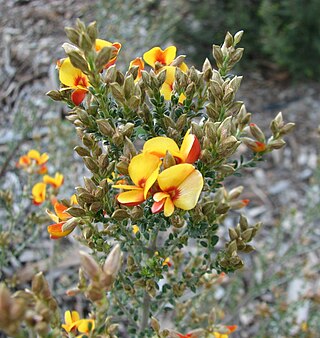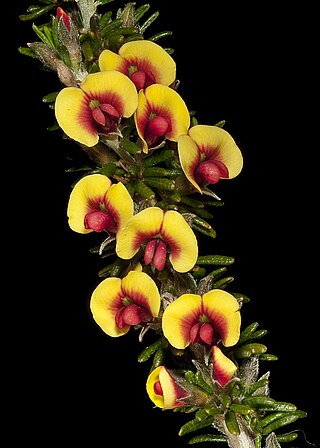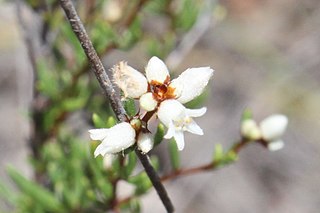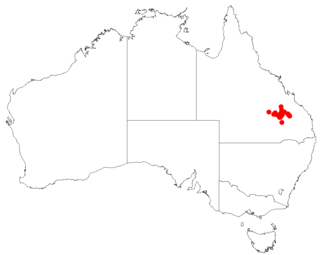
Mirbelia is a plant genus belonging to the family Fabaceae and is endemic to Australia, occurring in every mainland state except South Australia. Plants in the genus Mirbelia are prickly, perennial shrubs with simple, sometimes sharply-pointed leaves, or the leaves absent. The flowers are arranged singly or in groups in leaf axils or on the ends of branches, the sepals joined at the base with five teeth. The petals are usually red, orange, purplish or bluish and the fruit is an inflated pod.

Mirbelia oxylobioides, commonly known as mountain mirbelia or sandstone bushpea, is a species of flowering plant in the family Fabaceae and is endemic to south-eastern Australia. It is a low-lying or erect shrub with narrowly elliptic to egg-shaped leaves and orange-yellow and reddish-purple flowers arranged near the end of the branches.

Daviesia ulicifolia, commonly known as gorse bitter-pea, is a species of flowering plant in the family Fabaceae and is endemic to south-eastern Australia. It is a rigid, openly-branched shrub with sharply-pointed, narrow elliptic, narrow egg-shaped, rarely egg-shaped phyllodes and usually orange-yellow and dark red flowers.

Mirbelia rubiifolia, commonly known as heathy mirbelia, is a species of flowering plant in the family Fabaceae and is endemic to eastern Australia. It is a diffuse, spreading shrub with narrowly egg-shaped to linear, sharply-pointed leaves and clusters of pink to purple flowers.

Mirbelia baueri is a species of flowering plant in the family Fabaceae and is endemic to New South Wales. It is an erect or prostrate shrub with sharply-pointed linear leaves and orange and purple flowers.

Mirbelia speciosa is a species of flowering plant in the family Fabaceae and is endemic to eastern Australia. It is an erect shrub with narrowly linear leaves arranged in whorls of three, and bluish-purple flowers usually arranged singly in leaf axils.
Goodenia expansa is a species of flowering plant in the family Goodeniaceae and is endemic to Queensland. It is an annual or short-lived perennial herb with narrow elliptic to lance-shaped leaves at the base of the plant, and leafy racemes of pale yellow or cream-coloured flowers.
Goodenia splendida is a species of flowering plant in the family Goodeniaceae and is endemic to Queensland. It is an erect perennial herb with lance-shaped leaves mostly at the base of the plant, and racemes or thyrses of blue or purple flowers.

Dillwynia sieberi, commonly known as Sieber's parrot-pea, is a species of flowering plant in the family Fabaceae and is endemic to eastern Australia. It is an erect shrub with rigid, needle-shaped, sharply-pointed leaves and yellow to yellow-orange flowers with reddish-brown markings.

Daviesia discolor is a species of flowering plant in the family Fabaceae and is endemic to Queensland. It is a glabrous, multi-stemmed shrub with linear, more or less sickle-shaped phyllodes, and yellow and dark red flowers.

Mirbelia spinosa is a species of flowering plant in the family Fabaceae and is endemic to the south-west of Western Australia. It is a spiny shrub with narrowly linear leaves and yellow, orange and reddish-brown flowers.

Daviesia flava is a species of flowering plant in the family Fabaceae and is endemic to Queensland. It is a glabrous shrub with linear or narrowly egg-shaped phyllodes, and uniformly yellow flowers.
Daviesia pectinata, commonly known as thorny bitter-pea, is a species of flowering plant in the family Fabaceae and is endemic to south-eastern continental Australia. It is a dense, rigid shrub with erect, flattened branchlets, crowded, flattened, triangular phyllodes, and yellow to orange and reddish flowers.

Leucopogon blakei is a species of flowering plant in the heath family Ericaceae and is endemic to inland southern Queensland. It is a sometimes prostrate, twiggy shrub with hairy branches, egg-shaped leaves with the narrower end towards the base, and small white flowers.
Mirbelia balsiformis is a species of flowering plant in the family Fabaceae and is endemic to the far west of Western Australia. It is an erect to sprawling shrub with leaves reduced to triangular scales, and yellow to orange and red flowers arranged in racemes on the side of the branchlets.
Mirbelia corallina is a species of flowering plant in the family Fabaceae and is endemic to the far west of Western Australia. It is a slender, sprawling sub-shrub with a few narrowly elliptic to narrowly egg-shaped leaves and pink and yellow flowers arranged in racemes near the ends of the branchlets.
Mirbelia ferricola is a species of flowering plant in the family Fabaceae and is endemic to inland parts of the south-west of Western Australia. It is an erect shrub with leaves reduced to small scales, and red and yellow flowers arranged in racemes at the ends of the branches.

Cryptandra debilis is a species of flowering plant in the family Rhamnaceae and is endemic to north Queensland. It is a small shrub with clustered, linear leaves and densely-hairy, white, tube-shaped flowers.

Pimelea confertiflora is a species of flowering plant in the family Thymelaeaceae and is endemic to north Queensland. It is a shrub with densely hairy young stems, elliptic or narrowly elliptic leaves and spikes of yellowish-green or yellow, tube-shaped flowers.

Leucopogon grandiflorus is a species of flowering plant in the heath family Ericaceae and is endemic to Carnarvon National Park in south-eastern Queensland. It is a shrub with softly-hairy branchlets, oblong leaves and white flowers.














